인간이 범접할 수 없는 자연의 거친 폭풍우, 눈보라, 새벽녘의 해 뜨는 모습, 노을의 아름다움을 바다, 하늘에 표현하고 있다. 인간의 작은 일, 소소한 다툼, 잔 걱정, 하챦은 물질에 대한 탐욕 이러한 것들은 우스운 일이란 걸 깨우쳐 주는 작품.
이 글씨 클릭! 터너 자료.
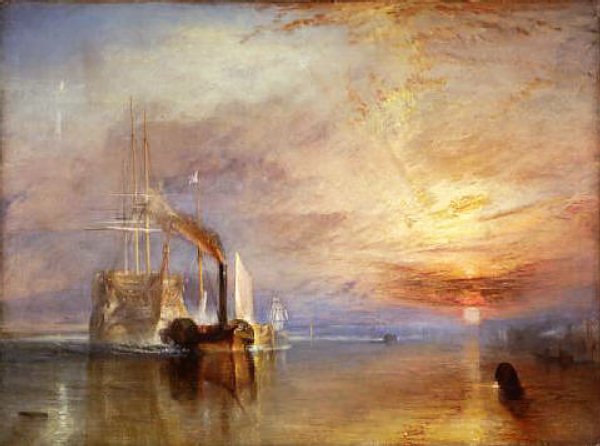
http://www.tate.org.uk/modern/exhibitions/
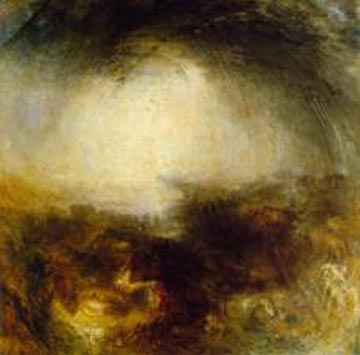
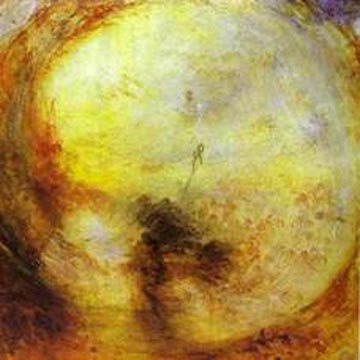
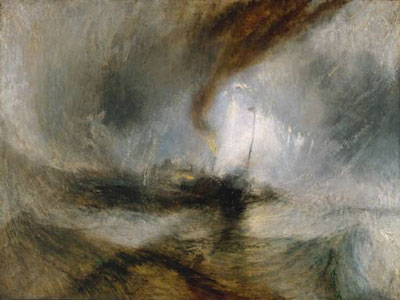
http://www.nga.gov/exhibitions/turnerinfo.shtm
National Gallery of Art, Washington, October 1, 2007–January 6, 2008; Dallas Museum of Art, February 10–May 18, 2008; The Metropolitan Museum of Art, New York, June 24–September 21, 2008
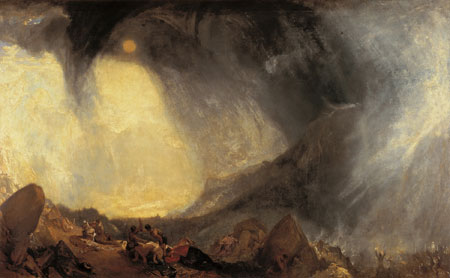
Snow Storm: Hannibal and His Army Crossing the Alps, 1812
oil on canvas
Tate, Bequeathed by the Artist, 1856
J.M.W. Turner film
This excerpt is from a new documentary chronicling the rise of one of the greatest landscape painters of all time, Joseph Mallord William Turner (1775–1851), who rendered the subtle effects of light and atmosphere in revolutionary ways. A barber's son, he entered the Royal Academy art school at age fourteen and became, over the course of six decades, the leading British artist of his era. This overview of Turner 's career and influences includes footage of locations important to him in Wales, Switzerland, and England, and readings from writers and artists of the era, including John Ruskin and Lord Byron. A 30-minute version of the film may be purchased at the National Gallery of Art. Narrated by Jeremy Irons and produced by the Gallery in conjunction with the exhibition J.M.W. Turner, the film is made possible by the HRH Foundation.
Joseph Mallord William Turner
British, 1775 - 1851
Turner was born on Maiden Lane in Covent Garden, London, in 1775 (the actual day is uncertain, but Turner maintained it was Saint George's Day, 23 April), the only son of William Turner and Mary Marshall. His mother, who was mentally unstable, was committed to Bethlem asylum for the insane in 1800, and died in 1804. During his only sister's fatal illness (she died in 1786) Turner was sent to live with his mother's brother in Brentford and attended Brentford Free School; this was his only formal education. His early artistic talent was encouraged by his father, who exhibited his drawings in his shop window (the father remained a devoted supporter and, later, was his son's studio assistant and general factotum until his death in 1829). In 1789, the year of his first extant sketchbook from nature, Turner entered the Royal Academy Schools, also working at about this time in the studio of the architectural draftsman and topographer Thomas Malton. He exhibited his first watercolor at the Royal Academy in 1790 and his first oil in 1796; thereafter he exhibited nearly every year until a year before his death. He stayed with his father's friend, John Narraway, in Bristol in 1791, and from then on until the end of the Napoleonic Wars made frequent summer sketching tours in various parts of Britain. In 1794 he published his first two engravings, and in 1798 began drawings for The Oxford Almanack. Probably beginning in 1794 he worked for three years at Dr. Monro's evening "academy" in the company of Thomas Girtin, Edward Dayes, and others.
Turner's precocity led to his election as an Associate of the Royal Academy in 1799, and to full Academicianship in 1802. He revered the Academy all his life, was assiduous as a member of the council and hanging committee and as auditor of the accounts, and was proud to be appointed its professor of perspective in 1807, from 1811 until 1828 giving lectures that ranged widely over the problems of landscape painting. He moved from Maiden Lane to lodgings on Harley Street in 1799, opening his own gallery in contiguous premises on Queen Anne Street in 1804; this he enlarged between 1819 and 1822. In 1805 he took a house at Isleworth, keeping a second home on the riverside at intervals for the rest of his life (Upper Mall, Hammersmith, from 1806 to 1811; Sandycombe Lodge, Twickenham, from 1813 to about 1825; Cheyne Walk, from about 1846 onward).
Turner made his first journey abroad in 1802, traveling through France to Switzerland, and studying in the Louvre on his return. In 1817 he visited the Low Countries and subsequently traveled more frequently on the Continent (until 1845), less frequently in the British Isles (until 1831). Between 1819 and 1820 he paid his first visit to Italy, staying principally in Venice and Rome; he revisited Venice in 1833, 1835 (probably), and 1840.
He worked continuously for the publishers of illustrated books; his illustrations appeared at intervals between 1827 and 1835. Turner made his reputation as a topographical watercolorist, sketching from nature, mainly in pencil, the sketches serving as a repository of ideas of which he might make use months or even years afterward. He was determined to raise landscape painting to the level of ideal art, closer in the hierarchy of genres to history painting, and he experimented first in watercolor then in oils with many new techniques.
For some twenty years, from about 1798, he maintained a liaison with Sarah Danby, with whom he had two daughters, but he never married. In old age, following the death of his father and close friends, he became increasingly pessimistic and morose, allowed the house and picture gallery on Queen Anne Street to become dilapidated, and finally lived largely in his cottage on Cheyne Walk, cared for by his housekeeper, Mrs. Booth. There he died on 19 December 1851. He was buried in Saint Paul's Cathedral, London. [This is an edited version of the artist's biography published, or to be published, in the NGA Systematic Catalogue]
Bibliographic References
- Thornbury, Walter. The Life of J. M. W. Turner, R.A.. 2 vols. London, 1862 (2d ed., 1877).
- Finberg, A. J. The Life of J. M. W. Turner, R.A. Oxford, 1939 (2d ed., 1961).
- Kitson, Michael. Turner. London, 1964.
- Gowing, Lawrence. Turner: Imagination and Reality. Exh. cat. Museum of Modern Art, New York, 1966.
- Butlin, Martin and Evelyn Joll. The Paintings of J. M. W. Turner. 2 vols. New Haven and London, 1977 (2d ed. rev., 1984).
- Wilton, Andrew. The Life and Work of J. M. W. Turner. London, 1979.
- Gage, John. J. M. W. Turner: "A Wonderful Range of Mind". New Haven and London, 1987.
- Hayes, John. British Paintings of the Sixteenth through Nineteenth Centuries. The Collections of the National Gallery of Art Systematic Catalogue. Washington, D.C., 1992: 261-264.
© Tate, London
'Exhibition > Painting&Prints' 카테고리의 다른 글
| Modigliani, Amedeo (0) | 2008.01.17 |
|---|---|
| True Romance (0) | 2008.01.17 |
| Gustave Courbet (0) | 2007.12.26 |
| 언어적 형상, 형상적 언어 : 문자와 미술展 (2) | 2007.12.26 |
| 제12회 BELT2008 선정작가展 (0) | 2007.12.25 |




